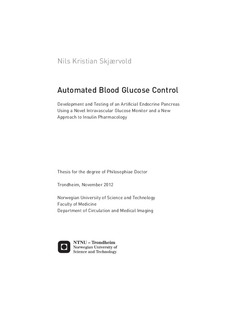| dc.contributor.author | Skjærvold, Nils Kristian | nb_NO |
| dc.date.accessioned | 2014-12-19T14:23:58Z | |
| dc.date.available | 2014-12-19T14:23:58Z | |
| dc.date.created | 2013-01-18 | nb_NO |
| dc.date.issued | 2012 | nb_NO |
| dc.identifier | 589537 | nb_NO |
| dc.identifier.isbn | 978-82-471-3863-2 (printed ver.) | nb_NO |
| dc.identifier.isbn | 978-82-471-3864-9 (electronic ver.) | nb_NO |
| dc.identifier.uri | http://hdl.handle.net/11250/264818 | |
| dc.description.abstract | This thesis describes the stepwise development and testing of the components of a novel artificial endocrine pancreas, consisting of a continuous glucose monitor, an insulin infusion device and a control algorithm. The starting point was the belief that current approaches to the challenges posed by creating an artificial endocrine pancreas do not work, and we identified some of the biological mechanisms that can explain this lack of success. We further established a set of research questions with the overall goal of constructing a working artificial endocrine pancreas.
The first paper describes the in vivo (pig model) testing of a prototype of a new intravascular continuous glucose monitor, the IvS-1. The study determined that the monitor was able to produce readings with a reasonably fast response time that highly agreed with simultaneously drawn blood samples. The second study examined the pharmacological properties of intravenous insulin boluses, and estimated the time delays from insulin administration until changes in the blood glucose level. The third study demonstrated that blood glucose levels were the same in the arterial and venous systems, even at times of great circulatory stress. The fourth study relied on our accumulated knowledge to enable us to construct an artificial endocrine pancreas using the IvS-1 and a novel insulin regulatory algorithm based on insulin boluses. We then regulated the blood glucose level in diabetic pigs in a proof-of-concept study.
The thesis concludes by answering the research questions, and asserts that the construction of an artificial endocrine pancreas is possible from a biological standpoint However, there are several serious technological challenges that have to be overcome in order to make a stable system for in-hospital – and later outpatient – use. | nb_NO |
| dc.language | eng | nb_NO |
| dc.publisher | Norges teknisk-naturvitenskapelige universitet, Det medisinske fakultet, Institutt for sirkulasjon og bildediagnostikk | nb_NO |
| dc.relation.ispartofseries | Doktoravhandlinger ved NTNU, 1503-8181; 2012:275 | nb_NO |
| dc.relation.ispartofseries | Dissertations at the Faculty of Medicine, 0805-7680; 581 | nb_NO |
| dc.relation.haspart | Skjaervold, Nils K; Solligård, Erik; Hjelme, Dag R; Aadahl, Petter. Continuous measurement of blood glucose. Anesthesiology. (ISSN 0003-3022). 114(1): 120-5, 2011. <a href='http://dx.doi.org/10.1097/ALN.0b013e3181ff4187'>10.1097/ALN.0b013e3181ff4187</a>. <a href='http://www.ncbi.nlm.nih.gov/pubmed/21169804'>21169804</a>. | nb_NO |
| dc.relation.haspart | Skjaervold, Nils K; Lyng, Oddveig; Spigset, Olav; Aadahl, Petter. Pharmacology of intravenous insulin administration. Diabetes Technology & Therapeutics. (ISSN 1520-9156). 14(1): 23-9, 2012. <a href='http://dx.doi.org/10.1089/dia.2011.0118'>10.1089/dia.2011.0118</a>. <a href='http://www.ncbi.nlm.nih.gov/pubmed/21751892'>21751892</a>. | nb_NO |
| dc.relation.haspart | Skjaervold, Nils K; Aadahl, Petter. Comparison of arterial and mixed venous blood glucose levels in hemodynamically unstable pigs. Acta Diabetologica. (ISSN 0940-5429). 49(6): 489-91, 2012. <a href='http://dx.doi.org/10.1007/s00592-012-0394-1'>10.1007/s00592-012-0394-1</a>. <a href='http://www.ncbi.nlm.nih.gov/pubmed/22527096'>22527096</a>. | nb_NO |
| dc.relation.haspart | Skjaervold, Nils K; Östling, Dan; Hjelme, Dag R; Spigset, Olav; Lyng, Oddveig; Aadahl, Petter. Blood glucose control using a novel continuous blood glucose monitor and repetitive intravenous insulin boluses – exploiting natural insulin pulsatility as a principle for a future artificial pancreas. . | nb_NO |
| dc.title | Automated blood glucose control: Development and Testing of an Artificial Endocrine Pancreas Using a Novel Intravascular Glucose Monitor and a New Approach to Insulin Pharmacology | nb_NO |
| dc.type | Doctoral thesis | nb_NO |
| dc.contributor.department | Norges teknisk-naturvitenskapelige universitet, Det medisinske fakultet, Institutt for sirkulasjon og bildediagnostikk | nb_NO |
| dc.description.degree | PhD i klinisk medisin | nb_NO |
| dc.description.degree | PhD in Clinical Medicine | en_GB |

